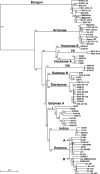The speciation and hybridization history of the genus Salmonella
- PMID: 31347998
- PMCID: PMC6755497
- DOI: 10.1099/mgen.0.000284
The speciation and hybridization history of the genus Salmonella
Abstract
Bacteria and archaea make up most of natural diversity, but the mechanisms that underlie the origin and maintenance of prokaryotic species are poorly understood. We investigated the speciation history of the genus Salmonella, an ecologically diverse bacterial lineage, within which S. enterica subsp. enterica is responsible for important human food-borne infections. We performed a survey of diversity across a large reference collection using multilocus sequence typing, followed by genome sequencing of distinct lineages. We identified 11 distinct phylogroups, 3 of which were previously undescribed. Strains assigned to S. enterica subsp. salamae are polyphyletic, with two distinct lineages that we designate Salamae A and B. Strains of the subspecies houtenae are subdivided into two groups, Houtenae A and B, and are both related to Selander's group VII. A phylogroup we designate VIII was previously unknown. A simple binary fission model of speciation cannot explain observed patterns of sequence diversity. In the recent past, there have been large-scale hybridization events involving an unsampled ancestral lineage and three distantly related lineages of the genus that have given rise to Houtenae A, Houtenae B and VII. We found no evidence for ongoing hybridization in the other eight lineages, but detected subtler signals of ancient recombination events. We are unable to fully resolve the speciation history of the genus, which might have involved additional speciation-by-hybridization or multi-way speciation events. Our results imply that traditional models of speciation by binary fission and divergence are not sufficient to account for Salmonella evolution.
Keywords: Salmonella; evolution; genomics; hybridization; speciation; taxonomy.
Conflict of interest statement
The authors declare that there are no conflicts of interest.
Figures





Similar articles
-
Evolutionary Genomics of Salmonella enterica Subspecies.mBio. 2013 Mar 5;4(2):e00579-12. doi: 10.1128/mBio.00579-12. mBio. 2013. PMID: 23462113 Free PMC article.
-
Mismatch induced speciation in Salmonella: model and data.Philos Trans R Soc Lond B Biol Sci. 2006 Nov 29;361(1475):2045-53. doi: 10.1098/rstb.2006.1925. Philos Trans R Soc Lond B Biol Sci. 2006. PMID: 17062419 Free PMC article.
-
Rapid classification and identification of salmonellae at the species and subspecies levels by whole-cell matrix-assisted laser desorption ionization-time of flight mass spectrometry.Appl Environ Microbiol. 2008 Dec;74(24):7767-78. doi: 10.1128/AEM.01402-08. Epub 2008 Oct 24. Appl Environ Microbiol. 2008. PMID: 18952875 Free PMC article.
-
Population structure, origins and evolution of major Salmonella enterica clones.Infect Genet Evol. 2009 Sep;9(5):996-1005. doi: 10.1016/j.meegid.2009.04.011. Epub 2009 Apr 23. Infect Genet Evol. 2009. PMID: 19393770 Review.
-
The Number and Type of Chaperone-Usher Fimbriae Reflect Phylogenetic Clade Rather than Host Range in Salmonella.mSystems. 2022 Jun 28;7(3):e0011522. doi: 10.1128/msystems.00115-22. Epub 2022 Apr 25. mSystems. 2022. PMID: 35467401 Free PMC article. Review.
Cited by
-
Through the Looking Glass: Genome, Phenome, and Interactome of Salmonella enterica.Pathogens. 2022 May 14;11(5):581. doi: 10.3390/pathogens11050581. Pathogens. 2022. PMID: 35631102 Free PMC article. Review.
-
A systematic survey of type I secretion systems and their substrate proteins in Salmonella.Virulence. 2025 Dec;16(1):2533414. doi: 10.1080/21505594.2025.2533414. Epub 2025 Jul 15. Virulence. 2025. PMID: 40662566 Free PMC article.
-
Phylogeny of Salmonella enterica subspecies arizonae by whole-genome sequencing reveals high incidence of polyphyly and low phase 1 H antigen variability.Microb Genom. 2021 Feb;7(2):000522. doi: 10.1099/mgen.0.000522. Microb Genom. 2021. PMID: 33539276 Free PMC article.
-
BlastFrost: fast querying of 100,000s of bacterial genomes in Bifrost graphs.Genome Biol. 2021 Jan 11;22(1):30. doi: 10.1186/s13059-020-02237-3. Genome Biol. 2021. PMID: 33430919 Free PMC article.
-
Distinct but Intertwined Evolutionary Histories of Multiple Salmonella enterica Subspecies.mSystems. 2020 Jan 14;5(1):e00515-19. doi: 10.1128/mSystems.00515-19. mSystems. 2020. PMID: 31937675 Free PMC article.
References
Publication types
MeSH terms
Grants and funding
LinkOut - more resources
Full Text Sources
Miscellaneous

